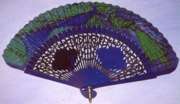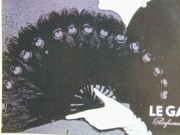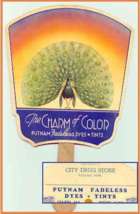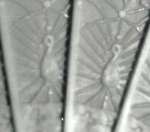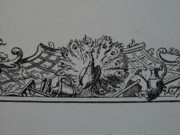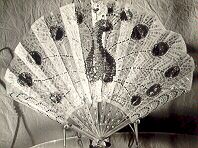
fig. 10,
photo post card,
No. 24 of the catalogue "Les éventails", Musée
du costume et de la dentelle, Brussels, described
as blond tortoiseshell sticks, silver sequins, approx.
1910
fig.
12
Celluloid-fan depicting 4 peacocks and a palm tree. The peacocks have
small peacock feathers applied. Austria, approx.
1905
[click the photo for bigger image and more info]
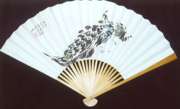
fig. 14
Chinese publicity fan for COAC airlines, approx. 1980
[click
the photo for bigger image and more info]
PEACOCK's PLEADINGS - 3rd and final page
Belle
Epoque/1900 until today
End of the 19 c./ beginning of the 20 century, new forms and
materials were deployed. The balloon (fontange) form (see fig.10) were
the latest fashion, as much as sequins and tinsels, remakes of the tiny
Empire-fans at the beginning of the 19 century.
Feather fans reach incredible dimensions and show fantastic
realizations, such as taxidermised birds' heads or applied minuscule
feathers glued to a big feather or other background, like a mosaic.
One such fan using tiny peacock-feathers is shown as No. 103 in the
catalogue of the "Mainfränkische Museum Würzburg"
(Library No.29). A wonderful example of an extreme peacock feather fan
is shown in C. Kammerl's book (No. 168, page 247, Library No. 23): Very
long peacock feathers from the tail are fixed into short, folding sticks
of Halliotis-mother of pearl that has a natural iridescence in the peacock
colours. Total length is 59 cm. The design of this fan is shown in "L'éventail
miroir de la Belle Epoque", see fig. 11 (Library No.65). This catalogue
can be purchased at the Musée de la Mode et du Costume, 10, Av.
Pierre 1er de Serbie, F-75116, Paris.
Celluloid fansticks allow cheaper mass production and
were produced in all kind of forms and colours, in particular ivory
and tortoise-shell imitations. Main producers were, after the USA and
GB, Austria, Germany and to a lesser extent Italy, see fig. 13.
Feathers were applied on celluloid brisé fans (fig.12), sometimes
taxidermised bird's heads, too. (see examples in C. Fendel's book on
Celluloid fans, Library No. 47).
Publicity fans become popular, cheap mass production, but often with an astonishing print design. The peacock is an often used motive. Its long tail most often is closed and follows the fan leave's semi-circle. Examples are Brunelleschi's fan for the Hotel Ritz (No. 51 Il ventaglio pubblicitario, Library No. 6), Vallé's design for Champagne Deutz (p.55, La folie des éventails, Library No.1), for Cognac Jacquet around 1920 (p. 152, op.cit) and the English fan for the Hotel Embassy Club, No. 66 of the catalogue "Wedeln und Werben" (Library No.31).
After
WW1, the female hand has no more use for a fan: emancipation
and work, handbag and cigarette leave no space for flirtatious fanning.
The roaring 20ies still produce some extreme feather fans but the end
of fan production is near. Only publicity fans show some more resistance.
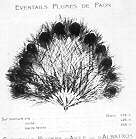
fig.11
Design by Duvelleroy of a peacock feather fan, in "L'éventail
miroir de la Belle Epoque"
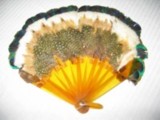
fig. 13
Small Celluloid feather fan; upper part of peacock feathers [click the
photo for bigger image and more info]
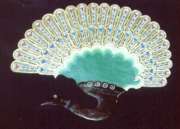
fig.15
Indonesian buffalo skin fan, punched and painted in the form of a spread
peacock tail; Peacock head and neck is made of buffalo horn, end 20
c.
[click the photo for bigger image and more info]

